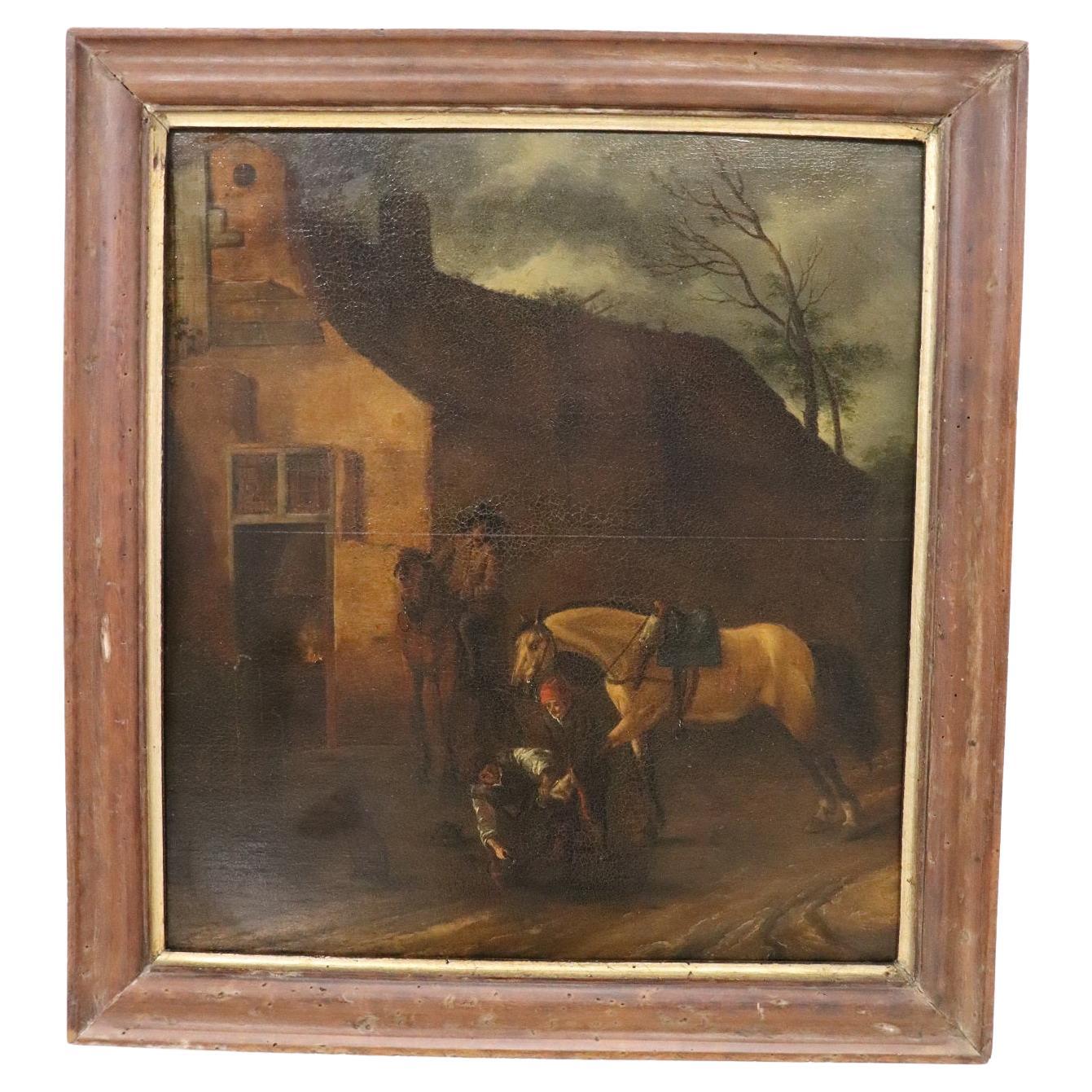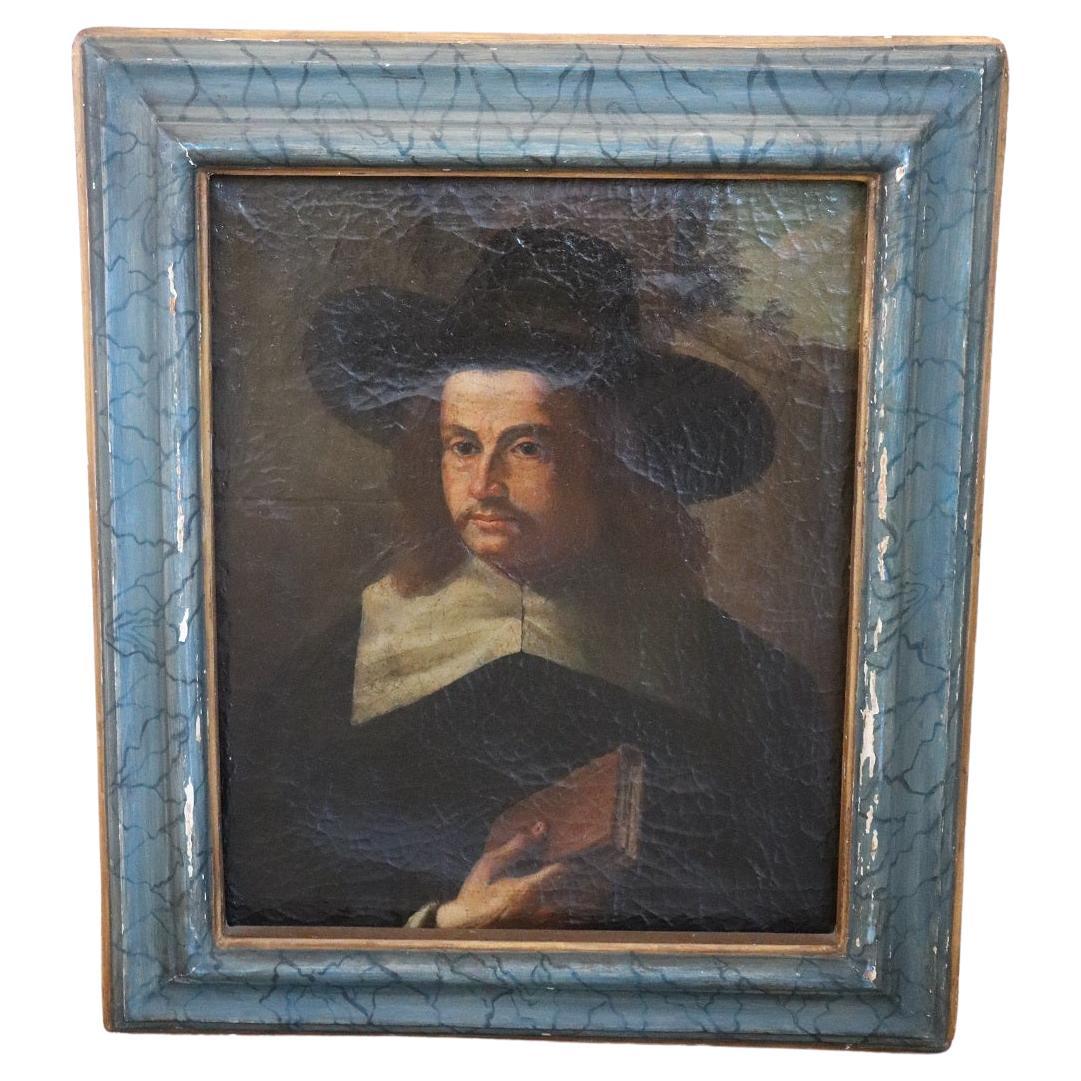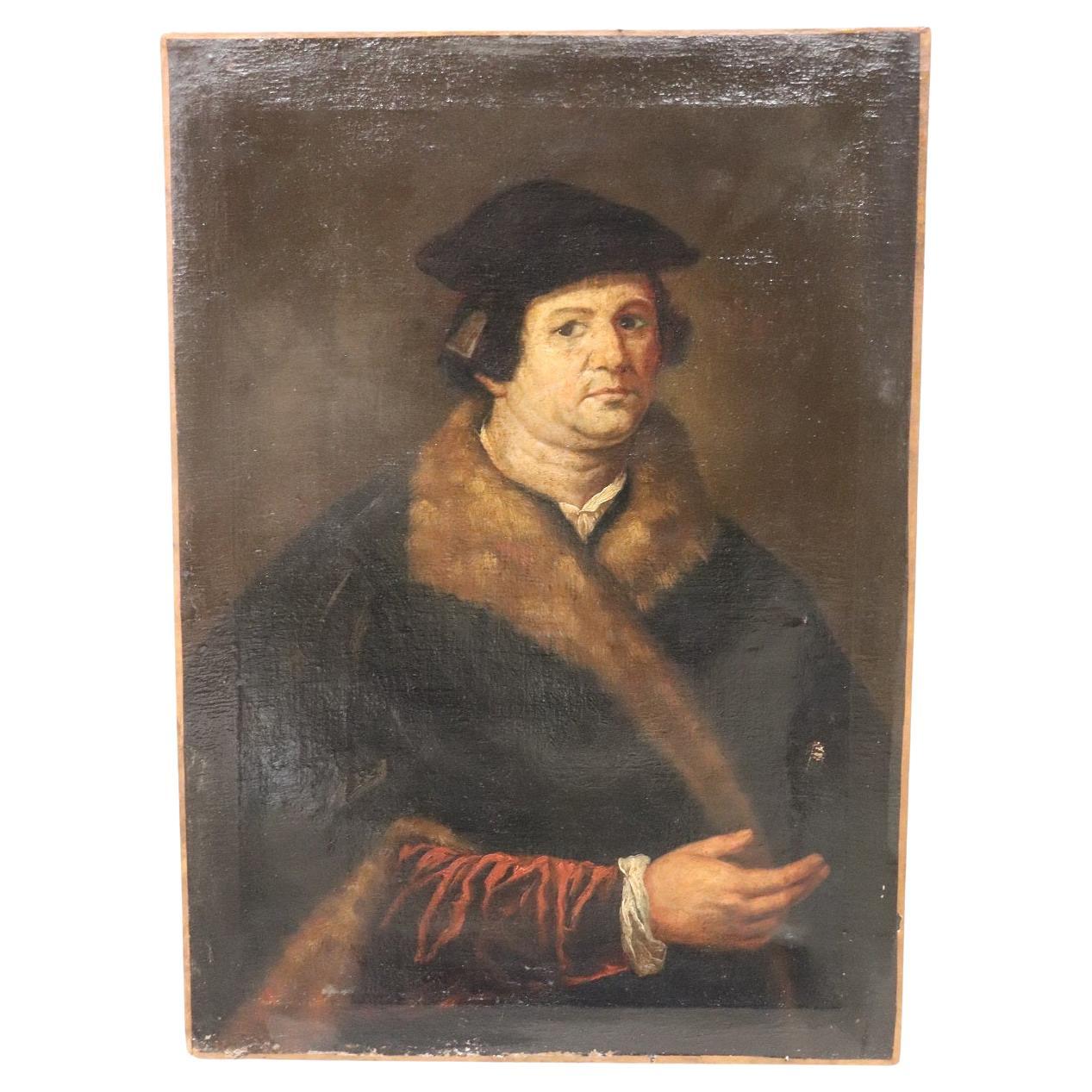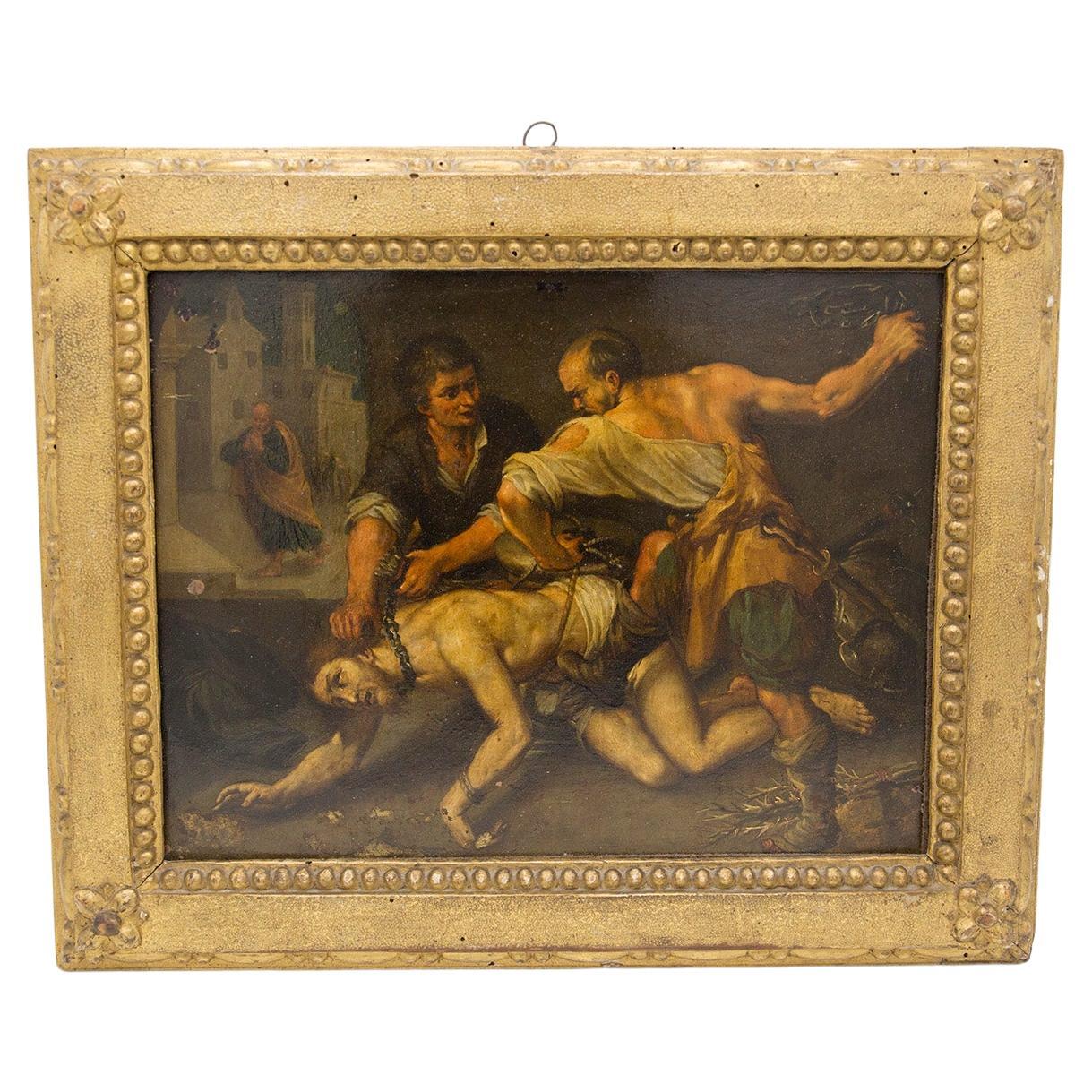Items Similar to 17th Century Christ in Chains Painting Oil on Canvas
Want more images or videos?
Request additional images or videos from the seller
1 of 10
17th Century Christ in Chains Painting Oil on Canvas
About the Item
17th century
Christ in chains
Oil on canvas, 95 x 71 cm
Frame 110 x 84 cm
The figurative tradition representing Christ with chained hands can be traced back to the early Middle Ages, when an iconography of His pains spread widely. The need to translate the Passion into images aimed to raise awareness of the forgiveness that has occurred for all men, consequent to the Crucifixion.
This painting depicts the moment before the audience before Pilate. Christ has not yet been cruelly mocked by the soldiers, despite the fact that he is already wearing the crown of thorns and the purple cloak: he still does not have the wounds caused by the beating. A man, with a typical oriental turban, looks at the viewer revealing the tied hands of the Redeemer, at the same time inviting a silent reflection about the destiny that is about to be fulfilled. The entire work is imbued with an intimate spirit of recollection, exalted by the gloomy background on which the illuminated, and above all illuminating, Christ stands out.
- Dimensions:Height: 43.31 in (110 cm)Width: 33.08 in (84 cm)Depth: 1.97 in (5 cm)
- Materials and Techniques:
- Place of Origin:
- Period:
- Date of Manufacture:17th Century
- Condition:Refinished. Wear consistent with age and use. The painting has been cleaned.
- Seller Location:Milan, IT
- Reference Number:1stDibs: LU5918226615552

About the Seller
5.0
Vetted Seller
These experienced sellers undergo a comprehensive evaluation by our team of in-house experts.
Established in 2000
1stDibs seller since 2021
25 sales on 1stDibs
Typical response time: 10 hours
- ShippingRetrieving quote...Ships From: Milan, Italy
- Return PolicyA return for this item may be initiated within 14 days of delivery.
More From This SellerView All
- 17th Century Virgin of the Assumption Painting Oil on CanvasLocated in Milan, IT17th century Virgin of the Assumption Oil on canvas, 93 x 81 cm Frame, 110 x 97 cm The present Assumption of the Virgin welcomes an innova...Category
Antique 17th Century Italian Paintings
MaterialsCanvas
- 17th Century Christ and the Samaritan Oil on Canvas Roman SchoolLocated in Milan, ITRoman school of the 17th century Landscape with bridge - Christ and the Samaritan woman at the well Oil on canvas, cm 42 x 59,5 - With frame, cm 54, 5 x 71 cm The small canvas portrays a broad view of the city surrounded by a bucolic and lush landscape, probably a reinterpretation of the Roman countryside or the Agro. The fulcrum of the canvas is the bridge consisting of several bays beyond which stands a village. In the distance the landscape made of green mountains opens into what looks like a lake crossed by boats. The landscape is animated by the human presence; not only small and fleeting figurines intent on walking along earthy paths but also the representation, in the foreground, of an Gospel episode, that of Christ and the Samaritan woman at the well. The landscape can be clearly traced back to a painter trained on the examples of the great seventeenth-century Roman baroque landscape that sees in the Lunette Aldobrandini by Annibale Carracci but also in Claude Lorrain, Nicolas Poussin and Gaspar Doghet are its greatest achievers. If in the past, therefore, the landscape was considered the scenic background on which to project the representation of divine or human characters, in the seventeenth century it became an autonomous and codified pictorial genre. With Carracci comes the so-called ideal landscape: a mental reconstruction of a peaceful and harmonious nature in which the dream of a perfect communion with man is realized. In the wake of Hannibal, as mentioned, during the seventeenth century the "classic" Roman landscape knows a long and happy season by artists such as Domenichino, and the French Claude Lorrain, Nicolas Poussin and Gaspar Dughet. Lorrain investigates the Roman countryside in all its aspects, studying the variations in the different hours of the day, the seasons or weather conditions, but always nourished by a sense of bucolic Virgilian. With Poussin the approach becomes intellectual elaboration and sophisticated rational construction. From the examples of the great masters, the Roman Baroque season, from the middle of the century, saw the flourishing of several personalities who, with shots, but also important personal reworkings, led to further spread the genre. Among the personalities that can be compared to the work in question we cannot fail to mention Crescenzio Onofri (1634-1714), defined by Salerno as the only true pupil of Dughet, who then spread in Florence the taste of the Baroque landscape influencing Tuscan painters such as Panfi and Peruzzini. His paintings are in various Roman collections; such as, for example, the landscapes from the Sacchetti Collection and today at the Pinacoteca Capitolina. and those in the Almagià collection in Rome, others in the Palazzo di Montecitorio, but the most conspicuous group is in the Galleria Doria. In comparison we can mention the two passages of the National Gallery in London, the landscape with a bridge over the Antiquarian Market but also the design of the National Gallery of Art in Washington. In the work you can also find the influences of the art of Giovanni Francesco Grimaldi...Category
Antique 17th Century Italian Paintings
MaterialsCanvas
- Venetian school, Transport of Christ to the Sepulcher, oil on canvas 17th centuryLocated in Milan, ITVenetian school, 17th century Transporting Christ to the tomb oil on canvas, 40 x 104.5 cm The exhaustion of the late Mannerist currents that had matured within the capital wor...Category
Antique 17th Century Paintings
MaterialsCanvas
- 17th Century Architectural Capriccio with Herds Painting Oil on CanvasLocated in Milan, ITCircle of Nicolaes Berchem (1620, Haarlem - 1683, Amsterdam) Architectural capriccio with herds Oil on canvas, 57.5 x 74 cm With frame 76 x 93 cm The examined canvas is...Category
Antique 17th Century Dutch Paintings
MaterialsCanvas
- 17th Century Roman Landscape Painting Oil on Canvas by BloemenLocated in Milan, ITWorkshop of Jan Frans van Bloemen (Antwerp, 1622 - Rome, 1749) Lazio landscape Oil on canvas, 48.5 x 64.5 cm The painting, to be considered belonging to the vast production...Category
Antique Late 17th Century Belgian Paintings
MaterialsCanvas
- 17th Century Annunciation Painting Oil on Canvas Workshop of NuvoloneLocated in Milan, IT17th century, Nuvolone workshop Annunciation Measures: Oil on canvas, 98.50 x 127.00 cm - with frame 144 x 115 Depicted is a canonical Annunciation which sees Mary on her knees ...Category
Antique 17th Century Italian Paintings
MaterialsCanvas
You May Also Like
- Spanish 17th Century Oil on Copper PaintingLocated in Atlanta, GAA wonderful 17th century oil on copper painting from the Catalan region of Spain housed in a beautiful frame of painted wood. The painting depicts a saint or a religious man...Category
Antique 17th Century Spanish Paintings
MaterialsCopper
- 17th Century Flemish Antique Oil Painting on BoardLocated in Casale Monferrato, ITBeautiful antique oil painting on wood board. Excellent pictorial quality. Flemish school of the 17th century. A scene of everyday life in the village where in the foreground a farrier works on the horse's hooves. Not signed. Sold with rare antique wooden frame.Category
Antique 1660s Dutch Paintings
MaterialsWood
- 17th Century Italian Antique Oil Painting on Canvas Portrait of a GentlemanLocated in Casale Monferrato, ITBeautiful antique oil painting on canvas portrait of a gentleman with book.. Excellent pictorial quality great attention to detail. Flemish school school of the 17th century. Not signed. Sold with rare 17th century antique wooden frame...Category
Antique 1660s Dutch Paintings
MaterialsCanvas
- 17th Century Antique Oil Painting on Canvas Portrait of a Gentleman with FurLocated in Casale Monferrato, ITBeautiful antique oil painting on canvas portrait of a gentleman with fur. Excellent pictorial quality great attention to detail. Flemis...Category
Antique 1660s Dutch Paintings
MaterialsCanvas
- Caravaggesque Oil on Copper "Flagellation of Christ" Baroque Sicilian, 17th CentBy (After) CaravaggioLocated in Milano, ITSplendid 17th-century Italian painting by unknown artist, but certainly a follower of Caravaggio, relying on style and drawing. The painting has a very beautiful gilded wooden frame, with a subtle greek with spheres and an overlying rectangular frame with sinuous flowers on each corner, very elegant and beautiful. The painting depicts one of the most depicted religious scenes ever, the scourging of Christ, and is entirely done in oil on copper. The scourging of Jesus is an episode narrated in the Gospels (Mk15:15-16; Mt27:26-27; Lk23:16-26; Jn19:1-17[1]). Scourging is a flogging, particularly bloody, by means of sticks, rods or cat-o-nine-tails, the latter instrument consisting, in the Roman typology, of a short stick to which were secured several strings ending in metal claws, leads and bone splinters that caused tremendous lacerations and fractures to the tortured person. Chains are used in this scene, both to immobilize Jesus Christ and to flog him, as we can see in the upper right hand of the scourger. According to some personal research, it turned out that the actual scourging of Christ was mostly depicted at the column, while this Christ is on the ground, so presumably Christ here is scourged during the Way of the Cross at one of those stages where he fell. The painting has a very dark coloring, which is why this painting is believed to faithfully follow Caravaggio's style of dry, authoritarian brushstrokes. The painting shows a figure agonizing on the ground that continues to receive beatings and floggings of all kinds, representing Christ; his face is crucified in a loquacious expression of pain, he turns his eyes to heaven as if to invoke God, but at the same time those same eyes admonish the wickedness and arrogance inherent in humanity. Christ has one hand resting on the ground in the act of holding himself, while the other takes a completely unnatural stance against the barren ground. His body appears hardened to wanting to parry the blows, his legs are curled up on his knees as he takes kicks from the soldier above him. Christ is depicted pinned down from the neck with a very large and strong black iron bolt held by the other soldier. The soldier on the right in the foreground wears a one-shoulder tunic with an orange tunic and blue pants. On his feet he wears gray shoes, at his waist he has a belt with an iron helmet...Category
Antique 17th Century Italian Baroque Paintings
MaterialsCopper
- 17th Century Italian Antique Oil Painting on Canvas Portrait of Pope Clemente IXLocated in Casale Monferrato, ITBeautiful antique Italian oil painting on canvas. Excellent pictorial quality great attention to detail. Italian school of the 17th century. Not signed. A beautiful religious painting, oval portrait of Pope Clemente IX. Sold with oval antique frame...Category
Antique 1660s Italian Paintings
MaterialsCanvas
Recently Viewed
View AllMore Ways To Browse
17th Italian Oil
17th Oil Italy
17th Century Italy Oil
17th Century Italian Oil
Italian Oil Painting 17th
17th Century Italian Oil Painting
Tie Chain
Chains Man
Antique Oriental Painting
Men In Tie
Chains For Men
17th Century Christ
Crucifixion Of Christ
Mens Italian Chains
95 Men
Mens 95
Mens Ties Framed
Man In Turban





